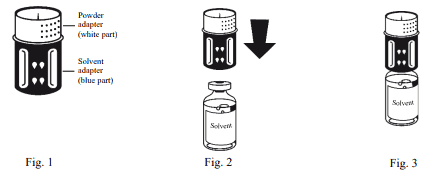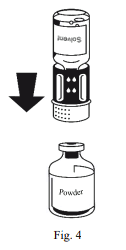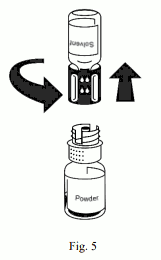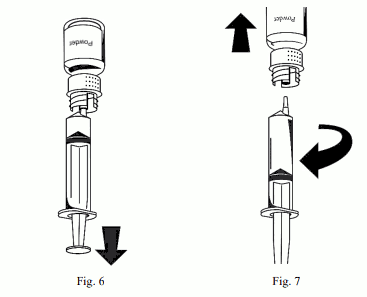WILATE Powder and solvent for solution for injection Ref.[50681] Active ingredients: Coagulation factor VIII Von Willebrand factor
Source: Health Products Regulatory Authority (IE) Revision Year: 2021 Publisher: Octapharma (IP) SPRL, Allée de la Recherche 65, 1070 Anderlecht, Belgium
4.1. Therapeutic indications
Von Willebrand disease (VWD)
Prevention and treatment of haemorrhage or surgical bleeding in von Willebrand disease (VWD), when desmopressin (DDAVP) treatment alone is ineffective or contra-indicated.
Haemophilia A
Treatment and prophylaxis of bleeding in patients with haemophilia A (congenital factor VIII deficiency).
4.2. Posology and method of administration
Treatment should be under the supervision of a physician experienced in the treatment of coagulation disorders. The product is of single use and the full content of the vial should be administered. In case any content remains, it should be disposed of in accordance with local requirements.
Von Willebrand disease (VWD)
The ratio between VWF:RCo and FVIII:C is 1:1. Generally, 1 IU/kg BW VWF:RCo and FVIII:C raises the plasma level by 1.5-2% of normal activity for the respective protein. Usually, about 20 to 50 IU Wilate/kg BW are necessary to achieve adequate haemostasis. This will raise the VWF:RCo and FVIII:C in the patients by approx. 30 to 100%.
An initial dose of 50 to 80 IU Wilate/kg BW may be required, especially in patients with VWD type 3, where the maintenance of adequate plasma levels may require higher doses than in other types of VWD.
Paediatric population
There are insufficient data to recommend the use of Wilate in children less than 6 years old.
Prevention of haemorrhage in case of surgery or severe trauma
For prevention of bleeding in case of surgery, Wilate should be given 1-2 hours before start of the surgical procedure. Levels of VWF:RCo of ≥60 IU/dl (≥60%) and FVIII:C levels of ≥40 IU/dl (≥40%) should be achieved.
An appropriate dose should be re-administered every 12-24 hours of treatment. The dose and duration of the treatment depend on the clinical status of the patient, the type and severity of bleeding, and both VWF:RCo and FVIII:C levels.
In patients receiving FVIII-containing VWF products, plasma levels of FVIII:C should be monitored to reveal sustained excessive FVIII:C plasma levels, which may increase the risk of thrombotic events, particularly in patients with known clinical or laboratory risk factors. In case excessive FVIII:C plasma levels are observed, reduced doses and/or prolongation of the dose interval or the use of VWF product containing a low level of FVIII should be considered.
Prophylaxis
For long term prophylaxis against bleeds in VWD patients, doses of 20-40 IU/kg bodyweight should be administered 2 or 3 times per week. In some cases, such as in patients with gastrointestinal bleeds, higher doses may be necessary.
Haemophilia A
Treatment monitoring
During the course of treatment, appropriate determination of factor VIII levels is advised to guide the dose to be administered and the frequency of repeated infusions. Individual patients may vary in their response to factor VIII treatment, demonstrating different half-lives and recoveries. Dose based on bodyweight may require adjustment in underweight or overweight patients. In the case of major surgical interventions in particular, precise monitoring of the substitution therapy by means of coagulation analysis (plasma factor VIII activity) is indispensable.
Posology
The dose and duration of the substitution therapy depend on the severity of the factor VIII deficiency, on the location and extent of the bleeding and on the patient's clinical condition.
The number of units of factor VIII administered is expressed in International Units (IU), which are related to the current WHO concentrate standard for factor VIII products. Factor VIII activity in plasma is expressed either as a percentage (relative to normal human plasma) or preferably in International Units (relative to an International Standard for factor VIII in plasma).
One International Unit (IU) of factor VIII activity is equivalent to that quantity of factor VIII in one ml of normal human plasma.
On demand treatment:
The calculation of the required dose of factor VIII is based on the empirical finding that 1 International Unit (IU) factor VIII per kg body weight raises the plasma level by 1.5 to 2% of normal activity. The required dose is determined using the following formula:
Required units = body weight (kg) x desired factor VIII rise (%)(IU/dl) x 0.5 IU/kg
The amount to be administered and the frequency of administration should always be oriented to the clinical effectiveness in the individual case. In the case of the following haemorrhagic events, the factor VIII activity should not fall below the given plasma activity level (in % of normal or IU/dl) in the corresponding period.
The following table can be used to guide dosing in bleeding episodes and surgery:
| Degree of haemorrhage/ Type of surgical procedure | Factor VIII level required (%) (IU/dl) | Frequency of doses (hours)/Duration of therapy (days) |
|---|---|---|
| Haemorrhage | ||
| Early haemarthrosis, muscle bleeding or oral bleeding | 20 - 40 | Repeat every 12 to 24 hours. At least 1 day, until the bleeding episode as indicated by pain is resolved or healing is achieved. |
| More extensive haemarthrosis, muscle bleeding or haematoma | 30 - 60 | Repeat infusion every 12 to 24 hours for 3 to 4 days or more until pain and acute disability are resolved. |
| Life threatening haemorrhages | 60 - 100 | Repeat infusion every 8 to 24 hours until threat is resolved. |
| Surgery | ||
| Minor surgery including tooth extraction | 30 - 60 | Every 24 hours, at least 1 day, until healing is achieved. |
| Major surgery | 80 - 100 (pre- and postoperative) | Repeat infusion every 8 to 24 hours until adequate wound healing, then therapy for at least another 7 days to maintain a factor VIII activity of 30% to 60% (IU/dl). |
Prophylaxis
For long-term prophylaxis against bleedings in patients with severe haemophilia A, the usual doses are 20 to 40 IU of factor VIII per kg body weight at intervals of 2 to 3 days. In some cases, especially in younger patients, shorter dosage intervals or higher doses may be necessary.
Continuous infusion
Prior to surgery, a pharmacokinetic analysis should be performed to obtain an estimate of clearance. The initial infusion rate can be calculated as follows:
Infusion rate (IU/kg/hr) = clearance (mL/kg/hr) x desired steady state level (IU/mL)
After the initial 24 hours of continuous infusion, the clearance should be calculated again every day using the steady state equation with the measured level and the known rate of infusion.
Paediatric population
There are insufficient data to recommend the use of Wilate in haemophilia A in children less than 6 years old.
Method of administration
Intravenous use.
The injection or infusion rate should not exceed 2-3 ml per minute. For instructions on reconstitution of the medicinal product before administration, see section 6.6.
4.9. Overdose
No symptoms of overdose with human VWF or factor VIII have been reported.
Thromboembolic events may occur in case of major overdose.
6.3. Shelf life
3 years.
The stability of the reconstituted solution has been demonstrated for 4 hours at room temperature (max. +25°C). Nevertheless, to avoid microbial contamination, the reconstituted solution should be used immediately.
6.4. Special precautions for storage
Store powder and solvent vial in a refrigerator (2-8°C). Keep the vials in the outer carton in order to protect from light. Do not freeze.
The product can be stored at room temperature (max. +25°C) for 2 months. In this case the shelf-life expires 2 months after the product has been taken out of the refrigerator for the first time. The new shelf-life has to be noted on the outer carton by the patient. The reconstituted solution should be used on one occasion only. Any solution remaining should be discarded.
For storage conditions after reconstitution of the medicinal product, see section 6.3.
6.5. Nature and contents of container
Package sizes:
Wilate, 500 IU VWF and 500 IU FVIII
1 package contains:
- 1 vial with Powder, type I glass, closed with a stopper (bromobutyl rubber) and sealed with a flip off cap
- 1 vial with Solvent (5 ml Water for Injections with 0.1% Polysorbate 80), type I glass, closed with a stopper (halobutyl rubber) and sealed with a flip off cap
- 1 equipment pack for intravenous injection (1 transfer set, 1 infusion set, 1 disposable syringe)
- 2 alcohol swabs
Wilate, 1000 IU VWF and 1000 IU FVIII
1 package contains:
- 1 vial with Powder, type I glass, closed with a stopper (bromobutyl rubber) and sealed with a flip off cap
- 1 vial with Solvent (10 ml Water for Injections with 0.1% Polysorbate 80), type I glass, closed with a stopper (halobutyl rubber) and sealed with a flip off cap
- 1 equipment pack for intravenous injection (1 transfer set, 1 infusion set, 1 disposable syringe)
- 2 alcohol swabs
Not all pack sizes may be marketed.
6.6. Special precautions for disposal and other handling
- Please read all the instructions and follow them carefully!
- Do not use Wilate after expiry date given on the label.
- During the procedure described below, sterility must be maintained!
- Reconstituted medicinal product should be inspected visually for particulate matter and discoloration prior to administration.
- The solution should be clear or slightly opalescent. Do not use solutions that are cloudy or have deposits.
- Use the prepared solution immediately, to prevent microbial contamination.
- Only use the infusion set provided. The use of other injection/infusion equipment can cause additional risks and treatment failure.
Instructions for preparing the solution
1. Do not use the product directly from the refrigerator. Allow the solvent and the powder in the closed vials to reach room temperature.
2. Remove the flip off caps from both vials and clean the rubber stoppers with one of the provided alcohol swabs.
3. The transfer set is depicted in Fig. 1. Place the solvent vial on an even surface and hold it firmly. Take the transfer set and turn it upside down. Place the blue part of the transfer set on top of the solvent vial and press firmly down until it snaps (Fig. 2 + 3).
Do not twist while attaching.
4. Place the powder vial on an even surface and hold it firmly. Take the solvent vial with the attached transfer set and turn it upside down. Place the white part on top of the powder vial and press firmly down until it snaps (Fig. 4). Do not twist while attaching. The solvent flows automatically into the powder vial.
5. With both vials still attached, gently swirl the powder vial until the product is dissolved. The dissolving is completed in less than 10 minutes at room temperature. Slight foaming might occur during preparation. Unscrew the transfer set into two parts (Fig. 5). Foaming will disappear.
Dispose the empty solvent vial together with the blue part of the transfer set.
Instructions for injection
As a precaution, your pulse rate should be taken before and during the injection. If a marked increase in your pulse rate occurs, reduce the injection speed or interrupt the administration for a short time.
1. Attach the syringe to the white part of the transfer set. Turn the vial upside down and draw the solution into the syringe (Fig. 6).
The solution should be clear or slightly opalescent.
Once the solution has been transferred, firmly hold the plunger of the syringe (keeping it facing down) and remove the syringe from the transfer set (Fig. 7).
Dispose the empty vial together with the white part of the transfer set.
2. Clean the chosen injection site with one of the provided alcohol swabs.
3. Attach the provided infusion set to the syringe.
4. Insert the injection needle into the chosen vein. If you have used a tourniquet to make the vein easier to see, this tourniquet should be released before you start injecting Wilate.
No blood must flow into the syringe due to the risk of formation of fibrin clots.
5. Inject the solution into the vein at a slow speed, not faster than 2-3 ml per minute.
If you use more than one vial of Wilate powder for one treatment, you may use the same injection needle and syringe again. The transfer set is for single use only.
Any unused product or waste material should be disposed of in accordance with local requirements.
© All content on this website, including data entry, data processing, decision support tools, "RxReasoner" logo and graphics, is the intellectual property of RxReasoner and is protected by copyright laws. Unauthorized reproduction or distribution of any part of this content without explicit written permission from RxReasoner is strictly prohibited. Any third-party content used on this site is acknowledged and utilized under fair use principles.



